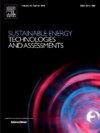在摇动溶剂辅助结晶中揭示传热动力学:从生物柴油中有效分离甘油
IF 7.1
2区 工程技术
Q1 ENERGY & FUELS
Sustainable Energy Technologies and Assessments
Pub Date : 2025-06-28
DOI:10.1016/j.seta.2025.104417
引用次数: 0
摘要
从粗棕榈油(CPO)中提纯生物柴油经常受到残留甘油和其他杂质的阻碍。本研究探讨了在晃动溶剂辅助结晶(SAC)系统中传热对提高甘油选择性凝固的作用。通过对冷却液温度(8 ~ 16℃)、结晶时间(15 ~ 35 min)和振动速度(11.05 ~ 31.85 cm/s)的影响进行评价,建立了综合传热模型,将系统划分为4个热区(冷却液、容器壁、固体甘油和生物柴油溶液)。傅里叶定律、牛顿冷却定律和潜热平衡方程在特定区域的假设基础上得到应用和改进。至关重要的是,这些模型与实际产出相关:甘油层的厚度、热去除率和凝固甘油的预测产率。结果表明,较低的冷却液温度和适度的搅拌有利于有效的甘油结晶,理论和实验产率之间的偏差保持在10%以下。关键发现表明,精确控制热梯度和溶液运动显著影响甘油层厚度,影响生物柴油纯度。该研究为优化通过结晶去除甘油提供了概念和实践框架,并加强了SAC系统在工业规模生物柴油净化方面的潜力。本文章由计算机程序翻译,如有差异,请以英文原文为准。
Unraveling heat transfer dynamics in shaking solvent-aided crystallization: toward efficient glycerol separation from biodiesel
Biodiesel purification from crude palm oil (CPO) is often hindered by residual glycerol and other impurities. This study investigates the role of heat transfer in a shaking solvent-aided crystallization (SAC) system to enhance the selective solidification of glycerol. By evaluating the effects of coolant temperature (8–16 °C), crystallization time (15–35 min), and shaking speed (11.05–31.85 cm/s), a comprehensive heat transfer model was constructed, segmenting the system into four thermal zones (coolant, vessel wall, solid glycerol, and biodiesel solution). Fourier’s law, Newton’s law of cooling, and latent heat balance equations were applied and refined based on zone-specific assumptions. Crucially, these models were related to practical outputs: the thickness of the glycerol layer, the rate of heat removal, and the predicted yield of solidified glycerol. The results showed that lower coolant temperatures and moderate agitation facilitate efficient glycerol crystallization, with deviations between theoretical and experimental yields remaining below 10 %. Key findings revealed that precise control of thermal gradients and solution movement significantly impacts glycerol layer thickness, influencing biodiesel purity. This study provides both a conceptual and practical framework for optimizing glycerol removal via crystallization and reinforces the SAC system’s potential for industrial-scale biodiesel purification.
求助全文
通过发布文献求助,成功后即可免费获取论文全文。
去求助
来源期刊

Sustainable Energy Technologies and Assessments
Energy-Renewable Energy, Sustainability and the Environment
CiteScore
12.70
自引率
12.50%
发文量
1091
期刊介绍:
Encouraging a transition to a sustainable energy future is imperative for our world. Technologies that enable this shift in various sectors like transportation, heating, and power systems are of utmost importance. Sustainable Energy Technologies and Assessments welcomes papers focusing on a range of aspects and levels of technological advancements in energy generation and utilization. The aim is to reduce the negative environmental impact associated with energy production and consumption, spanning from laboratory experiments to real-world applications in the commercial sector.
 求助内容:
求助内容: 应助结果提醒方式:
应助结果提醒方式:


